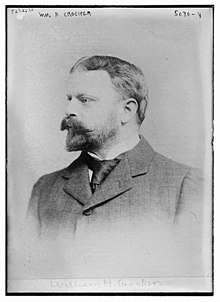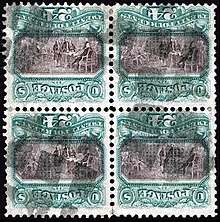William Henry Crocker
William Henry Crocker I (13 January 1861 – 25 September 1937) was the president of Crocker National Bank and a prominent member of the Republican Party.

Early life
He was born on 19 January 1861 in Sacramento, California.[1]
He attended Phillips Academy, Andover and Yale University, where he was a brother of the Delta Kappa Epsilon fraternity (Phi chapter). After the 1906 earthquake and fire had left the Crocker mansions in ruins, in 1907 he donated the Crocker family's 2.6-acre (11,000 m2) Nob Hill block for Grace Cathedral.[2]
Career
He was a member of the University of California Board of Regents for nearly thirty years and funded the Lawrence Radiation Laboratory's million-volt x-ray tube at the UC hospital and the "medical" Crocker cyclotron used for neutron therapy at Berkeley.[3]
Crocker also chaired the Panama-Pacific Exposition Committee and SE Community Chest, and was a key member of the committee that built the San Francisco Opera House and Veterans Building. Crocker was the founder of Crocker Middle School located in Hillsborough, California.
When much of the city of San Francisco was destroyed by the fire from the 1906 earthquake, William Crocker and his bank were major forces in financing reconstruction. His father, Charles Crocker (1822-1888), had been a builder of the Central Pacific Railroad.
Crocker's wife Ethel (née Sperry) was the leading patron of French Impressionist art in California at that time. In the 1890s, Crocker's wife, and California Impressionist Lucy Bacon, who studied in France under Pissarro, lent William Kingston Vickery, owner of the San Francisco art gallery Vickery, Atkins & Torrey, a number of French Impressionist paintings. Vickery then supervised a series of these loan exhibitions in San Francisco and introduced Impressionism to California in the form of paintings by Monet, Eugène Boudin, Paul Cézanne, Camille Pissarro, Pierre-Auguste Renoir, and Edgar Degas.
Mrs. Crocker also sponsored the studies of the Zoellner Quartet with César Thomson in Belgium. After six years in Europe, the quartet returned to the United States, and became a tireless force promoting classical music outside established centers and in Southern California.[4]
In 1936, Crocker contributed $75,000 toward the building of a laboratory for Ernest O. Lawrence at the University of California, Berkeley, which was subsequently named "Crocker Radiation Laboratory" in his honor.[5] This laboratory became home to the Berkeley 60" cyclotron. In the 1960s, parts of this cyclotron were moved to the University of California, Davis, where they served as the basis for the Crocker Nuclear Laboratory,[6] which inherited its name from the original[7][8].
Philately

Crocker was a noted philatelist and the owner of the unique block of four of the 1869 24c United States stamps with inverted centre formerly the property of William Thorne.[9][10]
Personal life
William and Ethel Crocker had four children: Charles, William Willard, Helen (Russell), and Ethel Mary (de Limur).
Death and legacy
William Crocker died on 25 September 1937 at his home in Hillsborough, California.[1]
His uncle's home in Sacramento, California, was converted into the Crocker Art Museum and was the first art museum to open in the West.
His nephew, Harry Crocker, was a movie star in the 1920s and, at one time, the personal assistant of Charlie Chaplin.
His cousin, Aimee Crocker, was a Bohemian mystic who garnered publicity for her extravagant parties in New York, San Francisco and Paris, for her five husbands and many lovers, for her tattoos, and for living 10 years in the Far East, not as a tourist, but as if a native.
His grandson, also named William, is a retired anthropologist who worked at the Smithsonian Institution specializing in Canela Indians of Brazil.[11]
The public middle school in Hillsborough, California is named after him, Crocker Middle School.
His Skyfarm mansion was purchased by W Clement Stone, and was donated to the Nueva School in 1971; the mansion currently houses Nueva's lower school division.[12]
References
- "W. H. Crocker Dies, Banker On Coast". New York Times. 26 September 1937. Retrieved 13 June 2018.
- "Plan Your Visit". Grace Cathedral. 2014-06-20. Retrieved 2017-01-07.
- J. L. Heilbron and Robert W. Seidel, Lawrence and His Laboratory (Berkeley: University of California, 1989)
- Cariaga, Daniel, "Not Taking It with You: A Tale of Two Estates", Los Angeles Times, December 22, 1985, accessed April 2012.
- "Lawrence and His Laboratory: A History of the Lawrence Berkeley Laboratory, Volume I, p.207-211". Retrieved 2 November 2017.
- "Crocker Nuclear Laboratory :: Home". Crocker.UCDavis.edu. Retrieved December 18, 2017.
- "A Cyclotron's Story". Retrieved 2 November 2017.
- "Building the Cyclotron". Retrieved 2 November 2017.
- Williams, L.N. & M. (1949) Stamps of Fame. London: Blandford Press. p. 210.
- United States Stamp Treasures: The William H. Gross Collection. Robert A. Siegel Auction Galleries, New York, 2018. pp. 196-201. Archived here.
- "Smithsonian Research". Anthropology.si.edu. Retrieved 2017-01-07.
- "The Nueva School - History". www.nuevaschool.org. Retrieved 2017-11-30.
External links
- The Political Graveyard: Index to Politicians: Crocker to Crocket at politicalgraveyard.com
- Cypress Lawn image